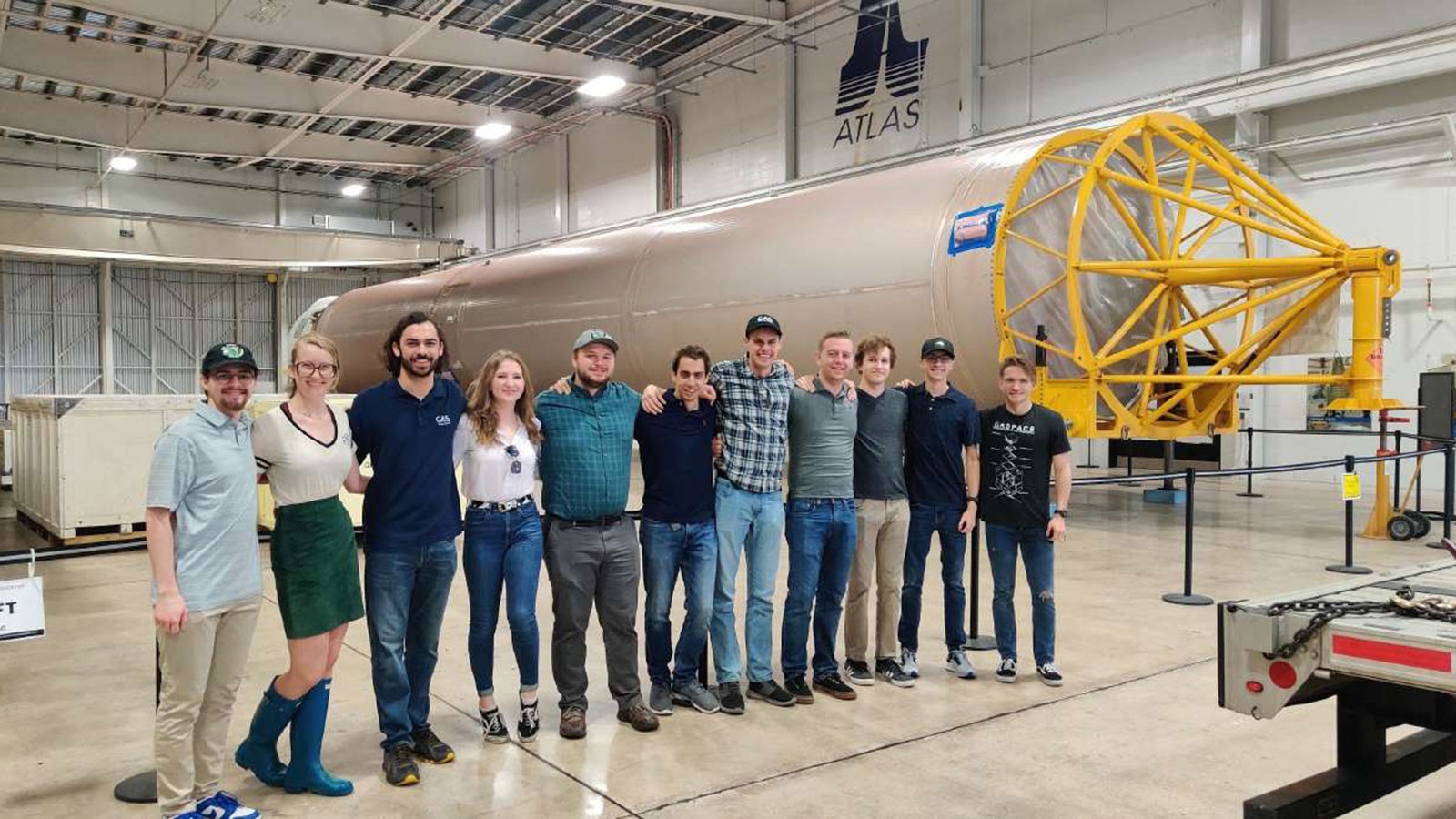UPDATE: USU Get Away Special Team CubeSat Deployment Pushed to Jan. 26.
Members of Utah State University's Get Away Special Team spotted the International Space Station this past week and marveled that a four-square-inch cube satellite they'd spent years designing and building was aboard.
By Mary-Ann Muffoletto |
Members of USU's 2021-22 Get Away Special Team traveled to Florida’s Kennedy Space Center to witness the Dec. 21 launch of the team’s cube satellite to the International Space Station. The team now eagerly awaits deployment of the satellite from the ISS.
UPDATE: The USU Get Away Special Team's GASPACS CubeSat deployment from the International Space Station has been rescheduled for Wednesday, Jan. 26, at a time to be announced.
Members of Utah State University’s Get Away Special Team spotted the International Space Station this past week and marveled that a four-square-inch cube satellite they’d spent years designing and building was aboard.
“It’s crazy to think our CubeSat is up there,” says Jack Danos, undergraduate coordinator of the student-led space research team. “This is not only the GAS Team’s first satellite sent into space; it’s Utah’s first solely undergraduate-built CubeSat — one of the first student-built satellites in the nation to launch into orbit.”
The satellite, named GASPACS (Get Away Special Passive Attitude Control Satellite), is set to be deployed from the ISS at 3:20 a.m. MST on Monday, Jan. 24.
Danos and his fellow team members will not only be watching a live-streamed video of the tiny box as it ventures from the mothership; they’ll be communicating with it.
“During NASA’s shuttle program, GAS team members launched experiments into space that were returned to them and they could retrieve collected data back on Earth,” Danos says. “That’s not the case here. GASPACS won’t return from space, so we had to build communications capability inside it to transmit data back to us, while it’s carrying out its mission.”
As GASPACS makes its solo space flight, GAS Team members will be capturing data from an antenna they’ve erected on top of USU’s Dean F. Peterson Engineering Laboratory Building.
“We have been working hard on our ground station equipment and software to ensure we are ready to communicate with our satellite,” he says. “We couldn’t be more excited.”
Danos and fellow team members traveled to Florida’s Kennedy Space Center over USU’s holiday break to watch the Dec. 21 launch of GASPACS aboard a SpaceX CRS-24 rocket delivering supplies to the ISS.
“It was an awesome experience,” says Danos, an undergraduate mechanical and aerospace engineering major, who’s led the team during the past two years. “We’re so grateful to everyone who’s been supporting us, including the departments of Physics, Computer Science, Electrical and Computer Engineering, Mechanical and Aerospace Engineering; the Space Dynamics Laboratory, the Utah NASA Space Grant Consortium, as well as USU alum Jim Elwell ’82, who was one of the first GAS Team members.”
GASPACS features a novel inflatable boom that addresses key challenges with deploying structures in space — of recent note, the James Webb Space Telescope that expanded to tennis court-size. Team members will be watching for GASPACS to transmit a photograph of its inflated boom as they witness its Jan. 24 deployment.
“It takes tremendous energy and expense to get an object into space, meaning that size and weight are large limitations on satellite designs,” Danos says. “GASPACS attempts to solve these problems with a compact boom, tucked into the satellite, that expands in space and acts as a passive-control mechanism.”
The meter-long boom, inflated by the pressure differential between travel from Earth’s atmosphere and space, uses restoring torque to maintain the satellite’s attitude without a power source, such as batteries and electromagnets.
Danos says GASPACS will fly much like an arrow on Earth, with the inflated boom trailing behind the main body of the satellite.
“Without the boom, the satellite would slowly spin as it orbits, but the small amount of air still present in low-Earth orbit allows the satellite, equipped with the boom, to aerodynamically stabilize,” he says. “You can imagine these principles — a compact design that expands in space and a passive control solution that requires no power sources — being applied to much larger structures needed for space exploration and research.”
Launch of GASPACS marks about 20 years since the GAS Team has sent an experiment into Earth’s orbit. The team is largely responsible for USU sending more student-built experiments into space than any other university in the world. From 1982 to 2001, the team sent at least 11 payloads containing more than 30 projects into space aboard NASA’s space shuttles.
GASPACS’ deployment coincides with a campus talk Wednesday, Jan. 26, by longtime GAS Team supporters and retired NASA astronauts Mary Cleave, a USU alumna, and Charles Precourt. The pair speaks at 4:30 p.m. in ENGR 101.
WRITER
Mary-Ann Muffoletto
Public Relations Specialist
College of Science
435-797-3517
maryann.muffoletto@usu.edu
CONTACT
Jack Danos
Student Coordinator
USU Get Away Special Team
jackadanos@aggiemail.usu.edu
Comments and questions regarding this article may be directed to the contact person listed on this page.







